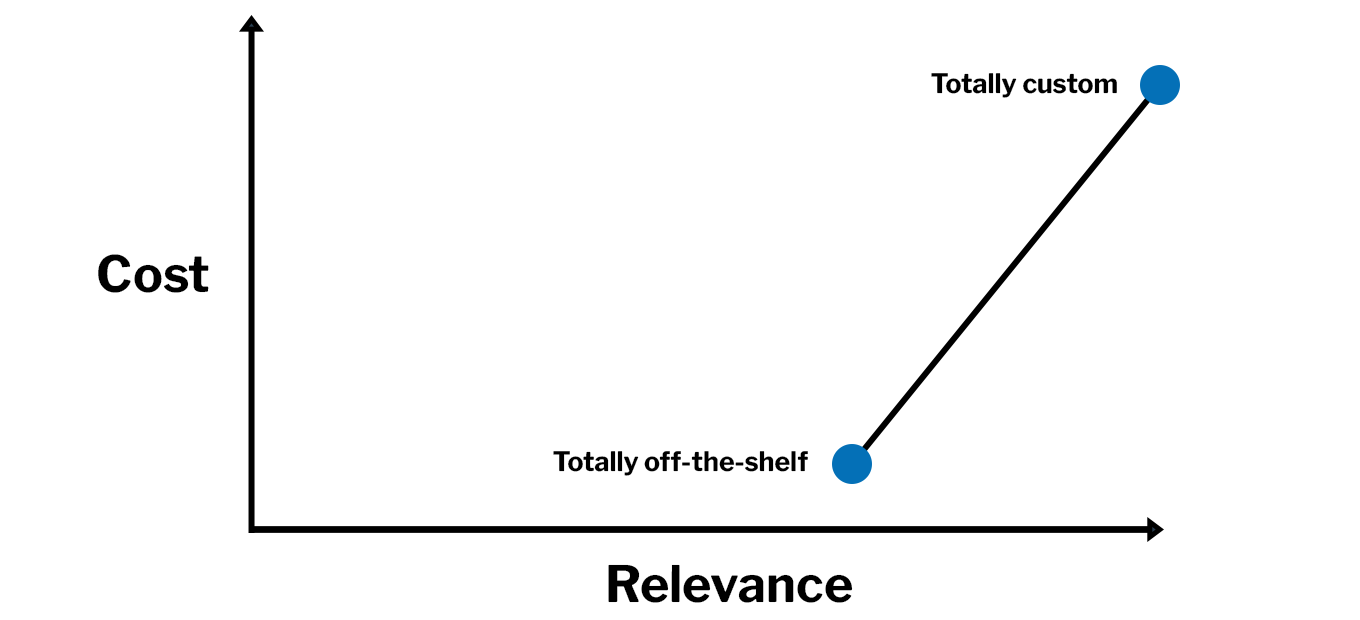Custom learning doesn't have to be more expensive
At least, not if you think long term...
In last week’s Dispatch, Ross G explored the trade-offs between off-the-shelf and custom learning solutions. Primarily, Ross focused on the balance between relevance and cost:
‘On the x-axis, we have Relevance: How useful and applicable is any learning intervention to the person who experiences it?
On the y-axis, we have cost: How much does it cost to provide that learning intervention to that person?
A well-designed off-the-shelf product should be broadly relevant to the target audience. A custom solution will be even moreso.
But Custom is also more expensive.
The question then becomes, what is the increased relevance worth?’
While I found most of Ross’s article persuasive (I mean, it’s got a graph!), I don’t buy the notion that custom learning is intrinsically more expensive than off-the-shelf.
Now, don’t worry, kids. This isn’t one of those situations where your parents start squabbling in the supermarket.
Ross G actively encourages this kind of constructive conflict on the Custom team, and you can rest assured that there’s no trouble in L&D paradise.
So, why don’t I accept the premise of Ross G’s argument?
Here are a few reasons:
🔻 Unlike off-the-shelf solutions, the cost of custom decreases over time.
Let’s imagine you’re an L&D buyer in the market for a leadership-development program. You have two options: purchase licenses for a ready-made solution, or invest additional time and money developing a program that’s tailored to your organization.
At first blush, the off-the-shelf option has a couple of obvious advantages, namely that it’s cheaper and ready to launch at short notice.
But on closer inspection, it’s not so clear-cut.
Assuming you plan on running your new program more than once, the cost of the custom option will come down every year, while the price of the off-the-shelf solution will remain constant or increase. If the custom program is twice as expensive as the off-the-shelf one, it will reach parity in the second year, and generate savings from the third year onwards.
🏡 Off-the-shelf is like renting your home. Custom is like owning it.
Now, let’s say you decide to work with the Mind Tools Custom team to design your leadership program. At the end of the project, the materials we’ve developed will be your organization’s intellectual property (with the exception of any licensed third-party content like stock footage or music).
Because you’ll have all the source files, you can do whatever you want with the content, without being tied to work with us again in the future — though we’d certainly hope that you’ll want to!
Like purchasing a home, buying a custom learning solution is an investment.
As an owner, you have the freedom to make changes to the solution as your organization’s needs evolve. You can pay a contractor to make those changes, but you can also make them yourself if you’re operating on a tight budget.
💸 Custom costs are typically fixed, while off-the-shelf costs generally scale with your organization.
Of course, what ‘expensive’ looks like will vary from one business to another.
If your organization has 20 managers, a fully customised, multi-modal leadership-development program may not give you the best value for money. In this case, off-the-shelf offers a high-quality solution for your management population that would be prohibitively costly to develop and deliver internally.
But let’s imagine your organization has 2,000 managers. Because the cost of that off-the-shelf option is calculated on a per-user basis, a fixed-price custom solution may start to look more appealing, particularly when you consider year-on-year licensing fees.
To wrap this up, I’m going to bring myself back into agreement with Ross G by quoting him directly:
‘The answer, for most organizations, is likely somewhere in between: taking advantage of the insights, testing and product development that has gone into off-the-shelf solutions, but layering on custom webinars, workshops, branding or scenarios to help connect those solutions with your organizational context.’
For me, the key word here is ‘context’. In some cases, off-the-shelf will make the most sense, while custom will be the right choice in others.
But custom isn’t necessarily the more expensive option.
Want to share your thoughts on this week’s Dispatch? Interested in working with the Mind Tools Custom team? Then get in touch by emailing custom@mindtools.com or reply to this newsletter from your inbox.
🎧 On the podcast
In the early stages of our careers we learn how to do our jobs, manage office politics, and earn promotion. But those habits and behaviors that initially help us advance can become a burden. We end up in meetings because it used to be important to show face, and not because they're an effective use of our time.
Last week on The Mind Tools L&D Podcast, we dipped into the archives to revisit Ross G and Owen’s conversation with Dom Price from Atlassian, where Dom shares his approach to ‘unlearning’ habits and behaviors.
Check out the episode below. 👇
You can subscribe to the podcast on iTunes, Spotify or the podcast page of our website. Want to share your thoughts? Get in touch @RossDickieMT, @RossGarnerMT or #MindToolsPodcast
📖 Deep dive
I love it when clients share research papers with me. So if any of you are wondering what to get me for Christmas, there’s a hint. 😉
In ‘The effectiveness of e-Learning on biosecurity practice to slow the spread of Invasive Alien Species’ (IAS), researchers from the University of Leeds surveyed a mix of students and professionals before and six months after they completed an e-learning module on IAS and biosecurity practices.
Based on the results, awareness of IAS and self-reported biosecurity practices increased across both groups. The authors write:
‘Students had a lower awareness of IAS than professionals before training (20% of students vs 60% of professionals), but after training students showed a greater increase in awareness which led to similar levels of awareness post-training (81%). Prior to training, risk perception was also lower amongst students than professionals (33% of students and 59% of professionals were aware of the risk that their activities posed to the accidental spread of IAS). There was no change in risk perception amongst professionals after training, however training led to a doubling of risk perception in students. E-Learning also led to an increase in reported biosecurity behaviour and cleaning practices and there were higher levels of biosecurity cleaning amongst professionals.’
As a learning designer, these results are encouraging because they demonstrate that e-learning is effective not only at changing behavior, but at establishing a common baseline for learners who approach the experience with varying levels of knowledge and understanding.
Shannon, C., Stebbing, P. D., Quinn, C. H., Warren, D. A., & Dunn, A. M. (2020). ‘The effectiveness of e-Learning on biosecurity practice to slow the spread of invasive alien species’. Biological Invasions, 22, 2559–2571.
👹 Missing links
📚 The Elite College Students Who Can’t Read Books
Based on interviews with teachers at some of America’s most prestigious universities, this Atlantic article explores students’ apparently diminishing ability to read books from cover to cover. One explanation for this phenomenon is shifting teaching practices in middle and high schools, where assignments are increasingly based on short passages of text, followed by questions on the author’s main argument or idea. By mimicking the format of standardized reading-comprehension texts, these assignments may prepare students for exams. But at what cost?
🗒️ NotebookLM: A Review 1 Year Later
Google’s NotebookLM is possibly my favorite AI tool. Less of a generalist than ChatGPT, Claude, or Gemini, NotebookLM is basically a notes app on steroids, allowing you to interrogate large volumes of text with the help of AI. In this edition of his newsletter, our friend Ross Stevenson reflects on his experience of using NotebookLM for a year, and offers advice on how to get the most out of the tool.
🤬 How Important is L&D’s “Language”?
I’m on the record for saying that L&D’s endless obsession with terminology is only valuable if it’s backed up by action. For Jess Almlie, the language learning professionals use is less important than the language business stakeholders use, particularly if we accept that L&D goal is to support the business. As Jess puts it, ‘Let’s get hung up on outcomes before we get hung up on semantics.’
👋 And finally…
I can only assume that I ate several pounds of turkey over Thanksgiving, but I’ll never know for sure. (Shoutout to Ben Betts for sharing this SNL sketch with me.)
👍 Thanks!
Thanks for reading The L&D Dispatch from Mind Tools! If you’d like to speak to us, work with us, or make a suggestion, you can email custom@mindtools.com.
Or just hit reply to this email!
Hey here’s a thing! If you’ve reached all the way to the end of this newsletter, then you must really love it!
Why not share that love by hitting the button below, or just forward it to a friend?



